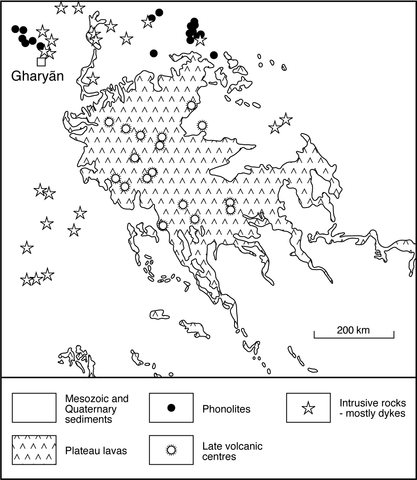stripes
An extensive volcanic field east of Gharyan, sometimes referred to as the Jebel Nefusa volcano (e.g. Bausch, 1978), extends over 3000 km2 and consists of plateau lavas, which are rarely more than a few 10s of metres in thickness, and valley fillings. Small composite volcanic centres are scattered over the lava plateau and phonolite plugs, laccoliths and domes, that are probably extrusive, also form hills. The lavas are essentially basalts with both hypersthene and nepheline normative varieties being present. In the south of the field they grade into picrobasalts. The volcanic centres are generally composite cones but scoria mounds also occur and central intrusive plugs are sometimes exposed. These rocks are younger than the plateau lavas. They are generally basanitic in composition and may contain up to 20% normative nepheline, while modal nepheline has also been identified. Lherzolite xenoliths have been found in some basanitic flows (Almond et al., 1974) details of the mineralogy of which are given by Busrewil and Wadsworth (1980a). The phonolites are confined to an east-west-trending 30x10 km zone in the northern part of the field (Bausch, 1980, Fig.1) and rarely are they in contact with the basic rocks. The structures of the phonolite occurrences are discussed and illustrated by Gray (1971). The phonolites consist of sanidine, sodic plagioclase, sodic pyroxene, amphibole, nepheline and analcime, with sodalite present in many rocks and natrolite in some; the analcime may form as much as 50% of the rock (Bausch, 1978). Trachytes also occur and Piccoli (1970) gives an analysis of one containing aenigmatite. Rock analyses are given by Almond et al. (1974), Piccoli (1970) and Busrewil and Wadsworth (1980a), the last also giving mineral analyses for the basanites. Palaeomagnetic data are presented by Ade-Hall et al. (1975b).
ADE-HALL, J.M., GERSTEIN, S., GERSTEIN, R.E., REYNOLDS, P.H., DAGLEY, P., MUSSETT, A.E. and HUBBARD, T.P. 1975b. Geophysical studies of North African Cenozoic volcanic areas: III. Garian, Libya. Canadian Journal of Earth Sciences, 12: 1264-71.ALMOND, D.C., BUSREWIL, M.T. and WADSWORTH, W.J. 1974. The Ghirian Tertiary volcanic province of Tripolitania, Libya. Geological Journal, 9: 17-28.BAUSCH, W.M. 1978. The central part of the Jebel Nefusa volcano (Libya). Survey map, age relationship and preliminary results. Geologische Rundschau, 67: 389-400.BAUSCH, W.M. 1980. Mineralogical composition of Jabal Nafusah phonolites. In M.J. Salem and M.T. Busrewil (eds) The geology of Libya, 3: 1107-15. Academic Press, London.BUSREWIL, M.T. and WADSWORTH, W.J. 1980a. The basanitic volcanoes of the Gharyan Area, NW Libya. In M.J. Salem and M.T. Busrewil (eds) The geology of Libya, 3: 1095-1105. Academic Press, London.GRAY, C. 1971. Structure and origin of the Gharian domes. In C. Gray (ed) Symposium on the geology of Libya, 307-19. University of Libya, Tripoli.PICCOLI, G. 1970. Outlines of volcanism in northern Tripolitania (Libya). Bollettino della Societa Geologica Italiana, 89: 449-61.

